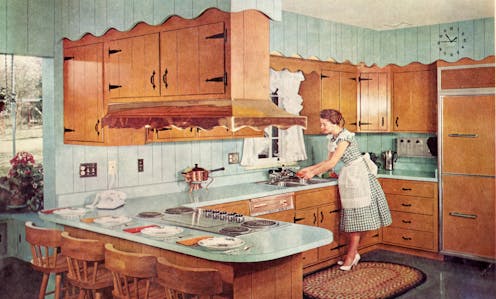
If you’ve been on TikTok or Instagram recently, you’ve likely come across trad wives. The trend features videos of young women influencers showcasing their domestic lives as trad or “traditional” wives.
The clips see them performing domestic activities that have traditionally been seen as the role of wives and mothers: taking care of the home, raising children, baking from scratch and even homesteading.
As with many social media trends, #tradwife has sparked debate and criticism about the content and who it is meant for. There have been attempts to chart the origins and history of the trad wives, their nostalgia for the past and their highly estheticized content.
There are connections to “momfluencers,” the “girl bosses” of the early 2010s and a general backlash against capitalism and the demands for feminized labour. However, there is an equally strong link to fundamentalist Christianity and concerns about white womanhood.
As scrutiny grows, especially given the uproar caused by the recent profile of trad wife Hannah Neeleman, also known as Ballerina Farm, one other connection bears consideration: Christian romance fiction.
Many of the characters of this genre of fiction display key qualities of trad wives.
In recent decades, Christian evangelicals have used cultural tools such as fiction and now social media to romanticize the lifestyle of white, westernized femininity. The stories often contain an emphasis on restricted public and domestic roles for women based on narrow ideas of biblical womanhood. In this way, such characters can be viewed as cultural predecessors to the trad wives.
Christian romance and purity
Mostly marketed to women, the genre gained ground with the publication of Canadian author Janette Oke’s first historical romance novel in 1979. The market for such fiction rapidly expanded, and the genre developed as consumer appetite grew. For example, Amish and Mennonite sub-genres have become very popular since American novelist Beverly Lewis began publishing in the late 1990s.
Though the genre of Christian romance fiction (or inspiration fiction as it is sometimes called) spans many different sub-genres and historical periods, it contains repeated themes about personal faith, sexual purity and heterosexual marriage. These themes encode gender and racial overtones within stories that focus predominantly on white women characters.
The sexual norms of these stories are not surprising, given longstanding Christian evangelical interest in how religious and sexual purity are meshed together.
Purity culture sets out highly prescriptive notions of sex, sexuality and gender roles. Scholars of religion such as Sara Moslener tie these norms directly to white Christian nationalist ideas of femininity. Religious notions of sexual purity become linked to racial purity through a concern for maintaining the integrity of the body of the white woman as well as the body of the nation against the threat of racialized others.
It’s no surprise that both Christian romance fiction and trad wives are overwhelmingly white, and that a number of trad wives have been documented as possessing links to the far right.
Romanticizing a mythical past
Theology professor Emily McGowin has noted how the “tradwife trend looks to a mythic past where everyone knew their role.” Writer Kathryn Jezer-Morton points out that trad wives uphold a romanticized notion of the past that is actually a fantasy. They often wear outfits that look like they are from the 1950s or a previous colonial era, and there is no clear definition of what the “trad wife” label is.
What and whose tradition are these fantasies representing? Certainly not all women, including many racialized and poor women who have never had the option of staying home. This nostalgic re-imagining of a very complex past whitewashes history and ignores how women had few legal or reproductive rights over their own bodies, finances or domestic lives.
So, too, have Christian romances fantasized about different historical moments, often in American history. There is a decidedly white Christian supremacist undertone to many of these stories. They often reiterate the goodness of westward expansionism in North America and erase (or use as a plot device) the physical and cultural genocide of Indigenous peoples across the continent. This is also true of Oke’s work, which features “pioneer” (settler) narratives and romanticizes the RCMP, a problem that continues in television adaptations of her books.
The Amish and Mennonite sub-genre further romanticizes what non-Amish and non-Mennonite authors portray as pre-modern (or even anti-modern) lifestyles. In these novels, there is little technology, an emphasis on agrarianism and homesteading, and hardly any physical contact among potential couples.
As one reviewer who grew up Amish puts it, at times it feels like romance writers and readers “superimpose their values on the Amish.” In other words, many Christian romance novels offer feel-good fantasies about an imagined past. This fantasy has little basis in how women — especially women of colour and Indigenous women — experienced those historical periods.
Like the social media accounts of trad wives, the sub-genre focuses on the aesthetics of a lifestyle rather than the very real legal, domestic, financial and racial implications of that life for women.
Marketing romance — and tradition
Romance fiction is often mocked as not being “serious” literature, but romance writers or readers are not necessarily passive or ignorant. Readers consume romances for a vast array of complex reasons, their faith or their relationships to romantic partners being only part of the mix.
However, the Christian romance genre is a publishing and marketing phenomenon, one that has sold millions upon millions of copies across North America alone. These romance novels are sold not just in niche Christian bookstores but in big box stores — even grocery store check-outs.
As Historian Daniel Silliman notes, the romance fiction genre was part of a larger Christian publishing boom that began in the 1950s in the United States. Fiction became an integral part of evangelical identity and an imagined community. It also played a crucial role in how evangelicals engaged with broader theological, cultural and political currents, though scholars question whether fiction shaped or reflected this engagement.
Their concerns about cultural change — be it sexual, demographic, or otherwise — influence their fiction. Literature and religion professor Christopher Douglas makes the crucial point that evangelical Christians don’t just “get their knowledge primarily through fact sheets or decontextualized data, but rather through the power of narrative.”
Christian romance fiction may not have caused the current iteration of trad wives, but its highly visible place in popular culture deserves greater scrutiny. These romance stories have contributed to ideas of westernized femininity that are notably white and decidedly constraining. They also provide romanticized visions of the past that lay a fictional groundwork for the appeal, and wide acceptance, that trad wives now enjoy on social media.
Brandi Estey-Burtt does not work for, consult, own shares in or receive funding from any company or organisation that would benefit from this article, and has disclosed no relevant affiliations beyond their academic appointment.
This article was originally published on The Conversation. Read the original article.







